Columba constellation is located in the southern sky. Its name means “the dove” in Latin. The constellation’s original name was Columba Noachi, meaning “Noah’s dove.” It was named after the biblical dove that informed Noah that the Great Flood was receding.
Columba was introduced by the Dutch astronomer Petrus Plancius in the late 16th century and later appeared in German astronomer Johann Bayer’s star atlas Uranometria of 1603.
The constellation is home to the blue subgiant Phact (Alpha Columbae) and the runaway star Mu Columbae. Notable deep sky objects in Columba include the barred spiral galaxy NGC 1808 and the globular cluster NGC 1851.
Facts, location and map
Columba is the 54th constellation in size, occupying an area of 270 square degrees. It lies in the first quadrant of the southern hemisphere (SQ1) and can be seen at latitudes between +45° and -90°.
The neighboring constellations are Caelum, Canis Major, Lepus, Pictor, and Puppis. Columba can be seen just south of Canis Major and Lepus.
The constellation name Columba is pronounced /koʊˈlʌmbə/. In English, the constellation is known as the Dove. The genitive form of Columba, used in star names, is Columbae (pronunciation: /koʊˈlʌmbiː/). The three-letter abbreviation, adopted by the International Astronomical Union (IAU) in 1922, is Col.
The constellation contains four formally named stars. The star names approved by the International Astronomical Union (IAU) are Elkurud (Theta Columbae), Kosjenka (WASP-63), Phact (Alpha Columbae), and Wazn (Beta Columbae).
Columba has one star brighter than magnitude 3.00 and no stars located within 10 parsecs (32.6 light years) of Earth. The brightest star in the constellation is Alpha Columbae, also known as Phact. The nearest star is Gliese 218, located at a distance of 48.89 light years from Earth. Columba has one star, designated WASP-63, (spectral class G8) with a transiting planet.
Columba belongs to the Heavenly Waters family of constellations, along with Carina, Delphinus, Equuleus, Eridanus, Piscis Austrinus, Puppis, Pyxis, and Vela. Columba does not contain any Messier objects. There are no meteor showers associated with the constellation.
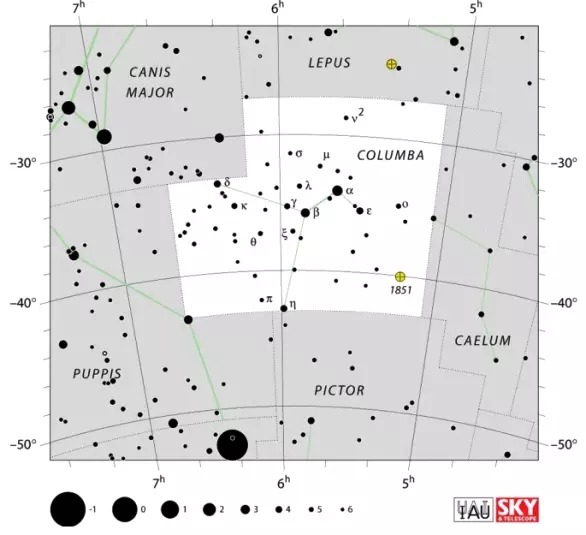
Columba constellation map by IAU and Sky&Telescope magazine
Columba myth
Columba represents Noah’s dove. Petrus Plancius created the constellation from the stars located behind Argo Navis, the constellation that represented the Argonauts’ ship and was later split into several smaller constellations. Plancius later renamed Argo Navis to “Noah’s Ark” on a celestial globe of 1613.
In the myth, Noah’s dove is sent from the Ark to see if there is any dry land left after the Great Flood. The bird returns holding an olive branch in its beak, signalling that the flood is receding. In some interpretations, Columba represents the dove sent by the Argonauts between the Clashing Rocks to ensure the Argonauts’ safe passage.
Columba stars
Phact – α Columbae (Alpha Columbae)
Phact is the brightest star in Columba. It belongs to the spectral class B7IVe. Its name is derived from the Arabic word Al-Fakhita, which means “the dove” or “ring dove.” The star has an apparent magnitude of 2.60 and is approximately 270 light years distant.
Phact is a double star composed of a Be-type subgiant, a suspected Gamma Cassiopeiae type variable with an apparent magnitude varying from 2.62 to 2.66, and a faint companion star with an apparent magnitude of 12.3. The primary star has an expanding gas shell surrounding it.
Wazn – β Columbae (Beta Columbae)
Wazn is a giant star belonging to the spectral class K1IIICN+1. Its name comes from the Arabic word for “the weight.” It is the second brightest star in the constellation, with an apparent magnitude of 3.12. Wazn is approximately 86 light years distant.
δ Columbae (Delta Columbae)
Delta Columbae is a spectroscopic binary star with a yellow giant for a primary component, belonging to the spectral class G7 III. It is approximately 237 light years distant and has an apparent magnitude of 3.853. Its traditional name, Ghusn al Zaitun, is derived from the Arabic phrase al-ghuşn al-zaitūn, which means “olive branch.” The giant star has a close companion with an orbital period of 2.38 years.
γ Columbae (Gamma Columbae)
Gamma Columbae is a blue subgiant (spectral class B2.5 IV) with an apparent magnitude of 4.35. It is located about 854 light years from the solar system.
μ Columbae (Mu Columbae)
Mu Columbae is a runaway star, believed to have been expelled from the Iota Orionis system in the Trapezium Cluster in Orion constellation. It is a fast rotating star that completes a full revolution every 1.5 days, belonging to the spectral class O9.5 V. It is one of the rare O-class stars that is visible to the unaided eye. Mu Columbae is approximately 1,300 light years distant and has an apparent magnitude of 5.15.
ε Columbae – Epsilon Columbae
Epsilon Columbae is a giant star belonging to the spectral class K1 IIIa. It is approximately 531 light years distant and has an apparent magnitude of 3.875.
η Columbae – Eta Culumbae
Eta Columbae is a yellow-orange giant (spectral type K0 III), 531.2 light years from Earth. It has an apparent magnitude of 3.946.
Deep sky objects in Columba
NGC 1808
NGC 1808 is a Seyfert galaxy approximately 40 million light years distant. It has an apparent magnitude of 10.8 and an apparent size of 6′.5 × 3′.9.
NGC 1808 is a barred spiral galaxy that shares a number of similarities with the Milky Way Galaxy. It has an unusual nucleus, shaped like a warped disk, and shows odd flows of hydrogen gas flowing out of the central regions. The galaxy is believed to have a lot of star forming activity occurring in it. A supernova designated SN 1993af, was observed in the galaxy in 1993.
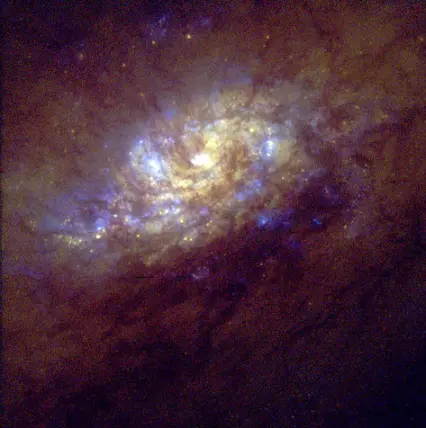
NGC 1808, image: Jim Flood (Amateur Astronomers Inc., Sperry Observatory), Max Mutchler (STScI)
NGC 1851
NGC 1851 (Caldwell 73) is a globular cluster in Columba. It has an apparent magnitude of 7.3 and is approximately 39,500 light years distant. The cluster occupies an area 11′ in size.
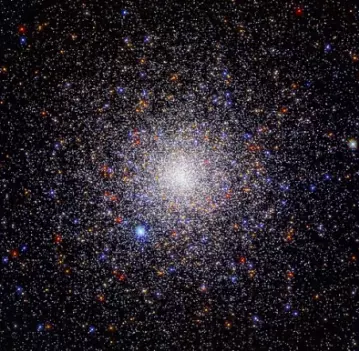
Caldwell 73, or NGC 1851, was discovered by the Scottish astronomer James Dunlop in 1826. It is located roughly 40,000 light-years from Earth in the constellation Columba and has an apparent magnitude of 7.3. This dense globular cluster can be spotted through a pair of binoculars, appearing as a fuzzy patch of light. Small telescopes will resolve some of the cluster’s individual stars, away from its compact center. Caldwell 73 is easiest to view from equatorial latitudes in the Northern Hemisphere during the winter and from the Southern Hemisphere during the summer. The stars in many known globular clusters are about the same age, indicating that the stars formed at roughly the same time. However, observations of Caldwell 73 reveal that it hosts stellar populations with different ages. The cluster is also encircled by a diffuse halo of stars. Although the origins of the halo and multiple star populations are unknown, one idea is that Caldwell 73 is a remnant of two clusters that collided within a dwarf galaxy that once hosted them both. When the clusters merged, the outer regions of the host galaxy may have been stripped away via interactions with more massive galaxies, leaving only the stellar nucleus and halo behind. Image: NASA, ESA, and G. Piotto (Università degli Studi di Padova); Processing: Gladys Kober (NASA/Catholic University of America)
NGC 1792
NGC 1792 is a spiral galaxy with an apparent magnitude of 10.2. It was discovered by the Scottish astronomer James Dunlop on October 4, 1826. The galaxy has an apparent size of 5’.62 x 2’.63.
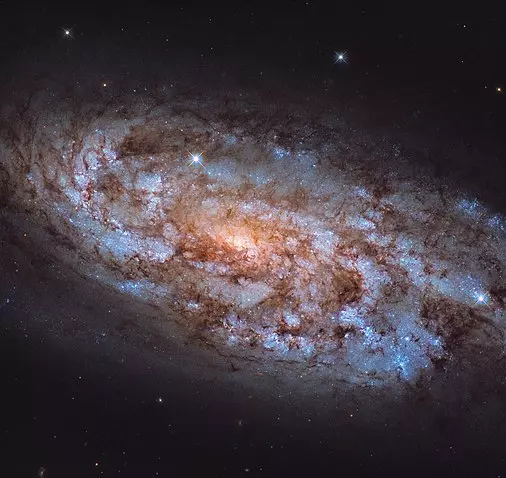
An orange glow radiates from the centre of NGC 1792, the heart of this stellar forge. Captured by the NASA/ESA Hubble Space Telescope, this intimate view of NGC 1792 gives us some insight into this galactic powerhouse. The vast swathes of tell-tale blue seen throughout the galaxy indicate areas that are full of young, hot stars, and it is in the shades of orange, seen nearer the centre, that the older, cooler stars reside. Nestled in the constellation of Columba (The Dove), NGC 1792 is both a spiral galaxy, and a starburst galaxy. Within starburst galaxies, stars are forming at comparatively exorbitant rates. The rate of star formation can be more than 10 times faster in a starburst galaxy than in the Milky Way. When galaxies have a large resevoir of gas, like NGC 1792, these short lived starburst phases can be sparked by galactic events such as mergers and tidal interactions. One might think that these starburst galaxies would easily consume all of their gas in a large forming event. However, supernova events and intense stellar winds produced in these powerful starbursts can inject energy into the gas and disperse it. This halts the star formation before it can completely deplete the galaxy of all its fuel. Scientists are actively working to understand this complex interplay between the dynamics that drive and quench these fierce bursts of star formation. Image: ESA/Hubble & NASA, J. Lee , acknowledgement: Leo Shatz
ESO 306-17
ESO 306-17 is a type cD3 (E+3) fossil group giant elliptical galaxy located at an approximate distance of 493 million light years from Earth. The galaxy spans about 1 million light years in diameter, which translates to an apparent size of 2.5 arc seconds. It has an apparent magnitude of 13.33.
ESO 306-17 appears alone in a volume of space and is believed to have cannibalized smaller galaxies in its neighbourhood. This is why it is considered to be a fossil group, or the end-result of a galaxy colliding and merging with a regular galaxy group.
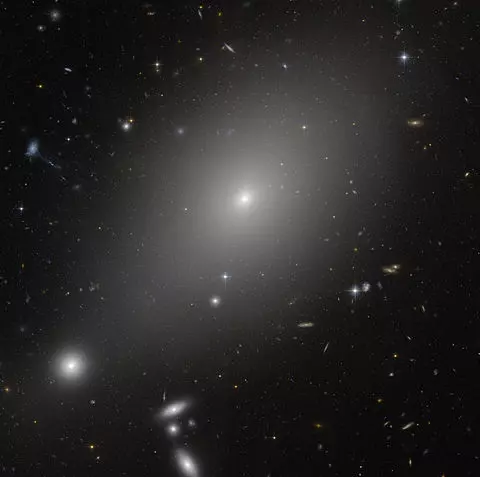
This image from the Advanced Camera for Surveys aboard the NASA/ESA Hubble Space Telescope highlights the large and bright elliptical galaxy called ESO 306-17 in the southern sky. In this image, it appears that ESO 306-17 is surrounded by other galaxies but the bright galaxies at bottom left are thought to be in the foreground, not at the same distance in the sky. In reality, ESO 306-17 lies fairly abandoned in an enormous sea of dark matter and hot gas. Image: NASA, ESA and Michael West (ESO)